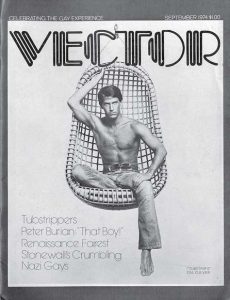Thirty years ago this month, we lost a pioneer in the crusade for sexual freedom. Casey Donovan did not organize rallies or picket businesses or lobby for political change. In an era when so many of us were deeply closeted and cowered by the cultural and legal stigmata placed upon gay men, he embodied the reality that “Gay is Good,” that our sexual desires are true and valid, that gay intimacy is normal and natural, and that gay life can be open, joyous, and without guilt.
Born John Calvin Culver in 1943, but not intentionally sharing a name with that most puritan of Protestant reformers, Donovan never intended to lead or even participate in a sexual revolution. He was going to be a teacher. Soon after taking a job at an exclusive school in New York City, however, he was fired for allegedly disciplining one of his students too harshly. He then decided that theater, which he loved, would be his career.
To pay his bills while waiting for his big opportunity, Culver took jobs as a salesman, a waiter, and a doorman, although his greatest success came from working as an escort. Eventually he got some walk-ons and small roles in Off-Broadway productions, making his Broadway debut in 1970. The next year he made his first screen appearance in Ginger, a low-budget, straight sexploitation film. Three more movies, all gay-themed, followed.
 The last of these made him an underground national celebrity, the first gay porn star. Different from every hardcore film that came before it, Boys in the Sand became the archetype for all that followed, beginning with its title. Instead of something pandering or squalid like Highway Hustler or Group Grope or Bisexual Built for Two, it played upon the name of Mart Crowley’s 1968 play and 1970 film Boys in the Band, which portrayed gay men as conflicted, pathetic, and ultimately alone.
The last of these made him an underground national celebrity, the first gay porn star. Different from every hardcore film that came before it, Boys in the Sand became the archetype for all that followed, beginning with its title. Instead of something pandering or squalid like Highway Hustler or Group Grope or Bisexual Built for Two, it played upon the name of Mart Crowley’s 1968 play and 1970 film Boys in the Band, which portrayed gay men as conflicted, pathetic, and ultimately alone.
Producer-director-scenarist Wakefield Poole’s film was no more realistic about gay life—all the men are beautiful, all the sex is wonderful—but at least it presented an ideal to which viewers could aspire, or a fantasy that they could enjoy. As the clean cut, sexually desirable—and available—golden boy-next-door, Culver, using the name Casey Donovan, became the quintessential gay man and the erotic star of stars.
Boys in the Sand led by example in almost every area. It was the first hardcore gay film to include credits for cast and crew, although many used noms de porn. It was the first to be advertised in The New York Times and the first to be reviewed by Variety; it appeared on the magazine’s list of the fifty top-grossing movies for almost three months. Many considered it “an artistically serious hardcore film” and it helped to define “porn chic,” which became popular in the early seventies.
In an era when it was illegal in almost every state and many considered it to be shameful, dishonorable, and malignant, Boys in the Sand presented same-sex intimacy between consenting adults as completely normal and deeply satisfying. Donovan was uninhibited, even exuberant, about his sexual self, which he continued to validate and celebrate across his career both on screen and off.
He paid a price for his success, of course. Although he and many others thought he could move from erotic to mainstream films, it never happened. “It was a rude awakening for me,” he said later, “to find out that Hollywood is one of the most closeted and hypocritical cultural centers in the world. I learned that an openly gay actor like myself was not welcome to gay directors and producers, who believe it is essential to keep their sexuality a secret.”
Both Donovan and Poole continued to be involved in filmmaking for gay adults, but also moved into other careers. In 1978, Donovan opened Casey Donovan in Key West, a guest house for visiting gay men. In 1981, he began leading all-gay tours, then still a novelty, to Italy, China, Peru and other destinations. His advice column, “Letters to Casey,” first appeared in Stallion magazine in 1982. It ran until shortly before his death, five years later.
 In 1975, after he moved to San Francisco, Poole and his lover Peter Schneckenburger, who appeared in Boys in the Sand as Peter Fisk, opened Hot Flash of America at 2351 Market Street. Living up to its motto—“Everything You Want But Nothing You Need!”—it was described by California Hotline as being “a super-creative store that is both an art gallery and a store with antiques and whatever—all distinctive.” Hot Flash of America also had a hair salon in the rear of the store, so customers could get all prettified for their Saturday date in the back, and buy him or her a gift in the front, all in one stop. Its logo t-shirts, modeled after the Arm & Hammer logo, soon became an essential item for every Castro clone’s wardrobe. Hot Flash of America closed in 1979.
In 1975, after he moved to San Francisco, Poole and his lover Peter Schneckenburger, who appeared in Boys in the Sand as Peter Fisk, opened Hot Flash of America at 2351 Market Street. Living up to its motto—“Everything You Want But Nothing You Need!”—it was described by California Hotline as being “a super-creative store that is both an art gallery and a store with antiques and whatever—all distinctive.” Hot Flash of America also had a hair salon in the rear of the store, so customers could get all prettified for their Saturday date in the back, and buy him or her a gift in the front, all in one stop. Its logo t-shirts, modeled after the Arm & Hammer logo, soon became an essential item for every Castro clone’s wardrobe. Hot Flash of America closed in 1979.
Donovan remained the personification of liberated sexuality throughout his life. He was then, and still is now, an authentic gay icon. By always being his unabashed, unembarrassed sexual self, he confirmed that gay desires are authentic and gay intimacy is compelling and joyous. If nothing else, he showed that the all-American boy was not as boy-next-door as he seemed to be. Or perhaps there was more to the boy-next-door than anyone had ever known before.
Bill Lipsky, Ph.D., author of “Gay and Lesbian San Francisco” (2006), is a member of the Rainbow Honor Walk board of directors.
Recent Comments